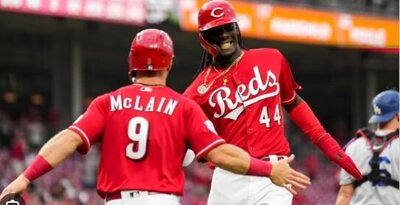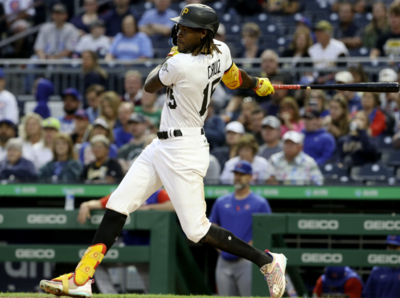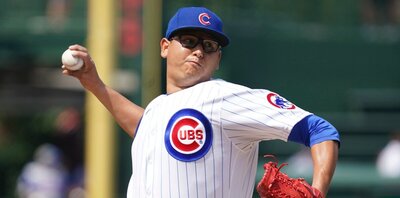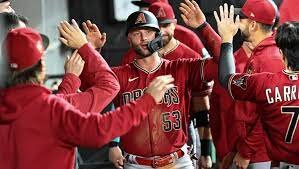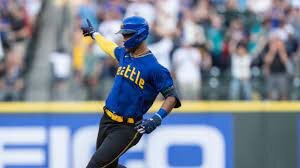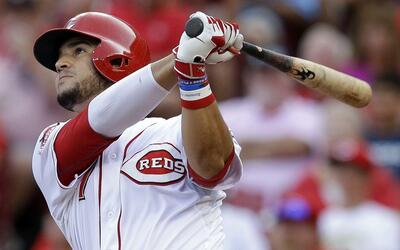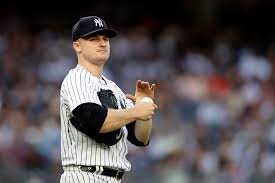Kendry Morales (DH/1B-LAA)- Morales went 2-for-6 with three strikeouts, two home runs and six RBI to help lead the Angels to a rout against the Rangers last night. He was able to improve his slash line to .271/.315/.420, and the home runs brought his season total to eleven. Morales will lose some playing time at DH with the return of Vernon Wells to the Angels roster, and will might be only featured against right-handed starters despite having a higher OPS (.759 vs. .731) against left-handers. While his numbers do not compare to the ones he put up in 2009-2010 before his ankle injury, they are not as quite off as one might think. His batted ball rate looks very similar to the one he produced in 2010, as his fly ball rate started to drop then and not after the ankle injury. Furthermore, Morales' HR/FB ratio of 17.5 percent is actually slightly higher than his career rate of 16 percent. His career best 22.5 percent line drive rate might regress to more fly balls in the future, but the only real difference in his numbers has been his strikeout rate. The 24 percent rate is a career worst, and has affected his overall line. Considering he missed more than a year and a half, I'm not entirely surprised by his 12 percent swinging strike rate.
Jim Johnson (RP-BAL)- Johnson recorded his 31st save of the season on Monday against the Yankees after working out of trouble in the inning. He allowed a double and a walk while striking out two in his inning of work to lower his ERA to 3.63. Johnson has struggled of late allowing a ton of base runners despite maintaining a below average BABIP of .259. A below average strand rate of 68.3 percent has helped to even out the affects of his BABIP, and his 3.79 FIP and 3.81 xFIP indicate that Johnson should continue to pitch to this type of ERA for the rest of the season unless he can improve his swinging strike rate (6.8 percent) and strikeout rate of 5.24 K/9. Even with his ineffectiveness of the last few weeks, Johnson is in no danger in losing his closer role unless that Orioles make a deal for one some time today. Pedro Strop's ERA might be impressive (1.34), but his 6.30 K/9 and 4.21 BB/9 indicate he wouldn't be much of an upgrade.
Adrian Gonzalez (1B-BOS)- Gonzalez went 2-for-4 with a run scored on Monday night against the Tigers to improve his slash line to .298/.338/.444 for the season. He has continued a torrid month of July in which he has hit .380/.387/.554 with four home runs. He has improved his season total of home runs to ten, but it is doubtful that he will be able to return to the power numbers he had shown in previous seasons. His 8.8 percent HR/FB ratio is the worst of his career as a regular and down almost eight percent from his 16.4 percent rate over the last two seasons. Much has also been made of Gonzalez's plate discipline over the last year, as he has posted his worst walk rate as a regular (5.3 percent). His 37.9 percent chase is a career high, but it is not much different from last season when he posted a 35.2 percent rate with a 10.3 percent walk rate. I'm starting to think this season may be more of an anomaly than shift toward a full time decline, but the last two months of the season will be important in determining his rank for next season.
Cole DeVries (SP-MIN)- DeVries did not earn a decision in the Twins 7-6 win over the White Sox last night. He allowed five runs (four earned) on seven hits and one walk while striking out three in five innings of work. His record remains at 2-2 while his ERA increased to 3.98 for the year. Despite a solid ERA, DeVries' FIP of 5.49 and xFIP of 4.64 are more indicative of the type of the numbers that he is likely to end the season with. While a HR/FB ratio of 15.8 percent is not likely to be sustained, neither is a .239 BABIP with a 24.5 percent line drive rate. Furthermore, his 29.2 percent ground ball rate is very troublesome. DeVries has been lucky considering that most of his home runs have been without many runners on base, but once his BABIP regresses, owners will see spike in his ERA. His strikeout rate of 6.23 K/9 is pleasantly surprising for a Twins starter, but owners should continue to stay away.
AJ Griffin (SP-OAK)- Griffin had another quality start on Monday night against the Rays. He allowed three runs on five hits, one home run and two walks while striking out six in seven innings of work. Griffin did not earn a decision in the fifteen-inning affair, as his record remains at 3-0 and has a strong 2.51 ERA in 43 innings. Griffin does not throw exceptionally hard (averages 89.9 mph with fastball), but he has induced a strong number of swinging strikes (9 percent) with his slider/curveball/change-up repertoire. With a 65.5 percent first pitch strike rate, his of 2.09 BB/9 looks to be a real skill. Griffin has benefitted from an 85.7 percent strand rate and .229 BABIP, but a 3.66 FIP and 3.96 xFIP indicate he can continue to pitch effectively despite an obvious regression. Pitching in Oakland should be able to lessen the effects of the aforementioned regression, and his 7.33 K/9 should be able to remain somewhat stable over the course of the season. He looks to have solidified a spot in the rotation with his seven quality starts, and I would recommend him in any league.
Follow us on Twitter all year: @Fantistics and @enehsy

